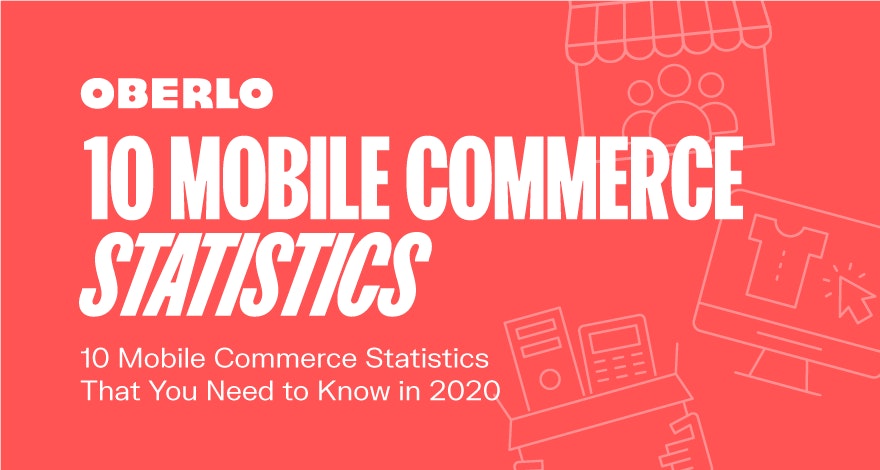Looking to get into ecomerce? Or maybe you’re already running an online store. Regardless, if this is the direction you want to go towards, it’s important to understand the growing trends of ecommerce.
This includes the rising phenomenon that is mobile commerce. Considering its potential to generate sales for your online business, it’s certainly not something you want to ignore.
If you need more hard facts, read on. In this post, we’ll dive into the ten most important mobile commerce statistics you need to know in 2021.
From the m-commerce growth rate to shopping habits of mobile users, we’ll cover it all. Let’s get straight to it.
Post Contents
- 1. Rise of M-Commerce
- 2. Smartphone Usage While Shopping
- 3. US Mobile Commerce Activities
- 4. Mobile Usage Accessing the Internet
- 5. Use of Smartphones for M-Commerce
- 6. Number of Mobile Buyers in the US
- 7. Mobile Payments in the US
- 8. Global Mobile Ecommerce Sales
- 9. Smartphone Usage for Product Research
- 10. Most Popular Ecommerce Apps in the US
- Conclusion
- Summary: Mobile Commerce Statistics
- Want to Learn More?



1. Rise of M-Commerce
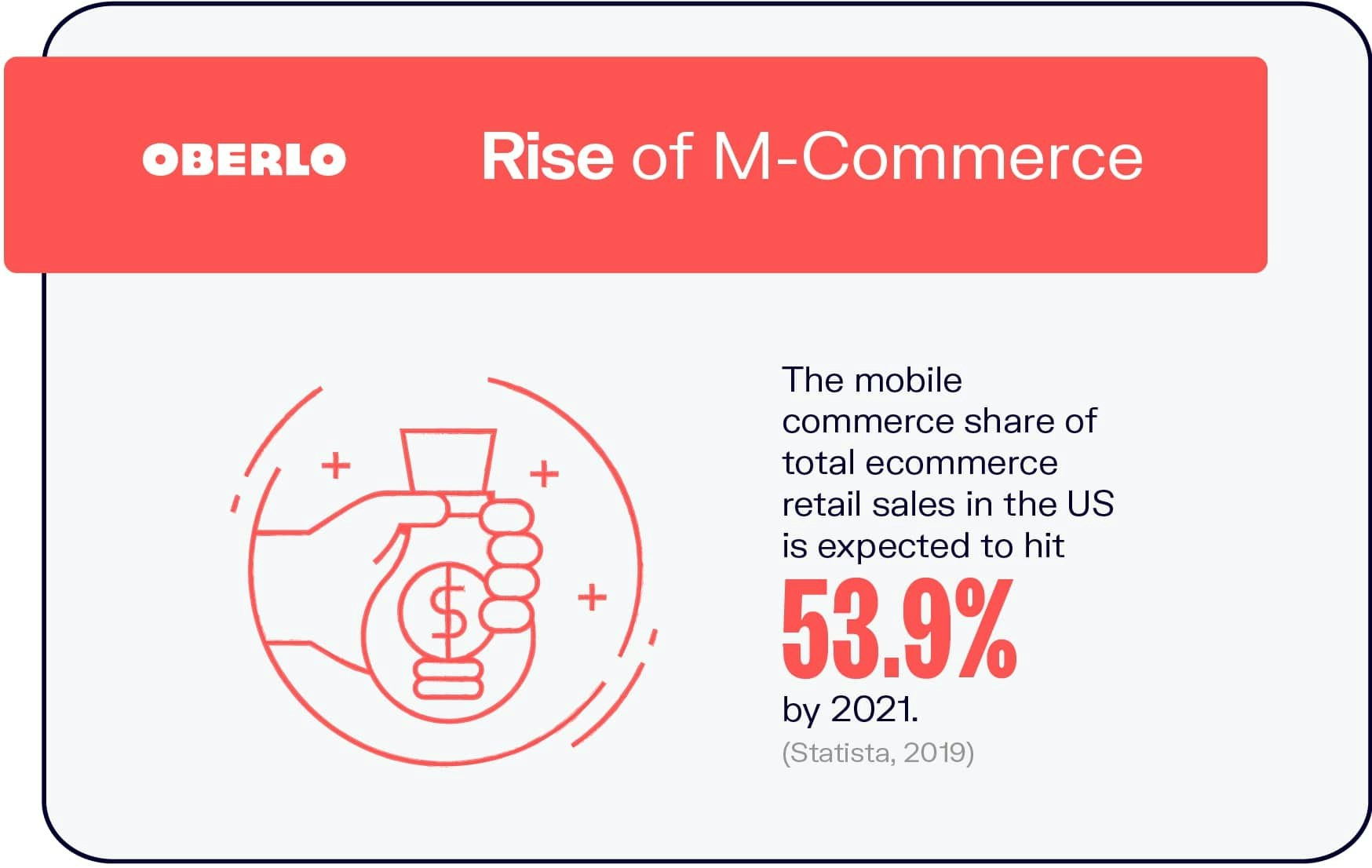
To start, let’s establish how popular mobile commerce has become and how it will continue to grow in the next few years.
→ Click Here to Launch Your Online Business with Shopify
Experts forecast that by 2021, 53.9 percent of the total annual retail ecommerce sales in the United States will come from mobile commerce (Statista, 2019). In other words, more than half of the money US consumers spend on shopping online will be done via mobile devices like smartphones and tablets.
This is a 9.6 percent increase from the 49.2 percent forecast for this year, which is actually the slowest annual increase in at least four years. The fastest growth in recent years has come from 2017 to 2018, during which the share of mobile commerce sales of total retail ecommerce sales grew 14.8 percent.
Despite the slight slowdown, it’s still an impressive rise from 2017. In the four-year period from 2017 to 2021, the mobile commerce share of total ecommerce sales is expected to grow by a whopping 56.2 percent.
2. Smartphone Usage While Shopping
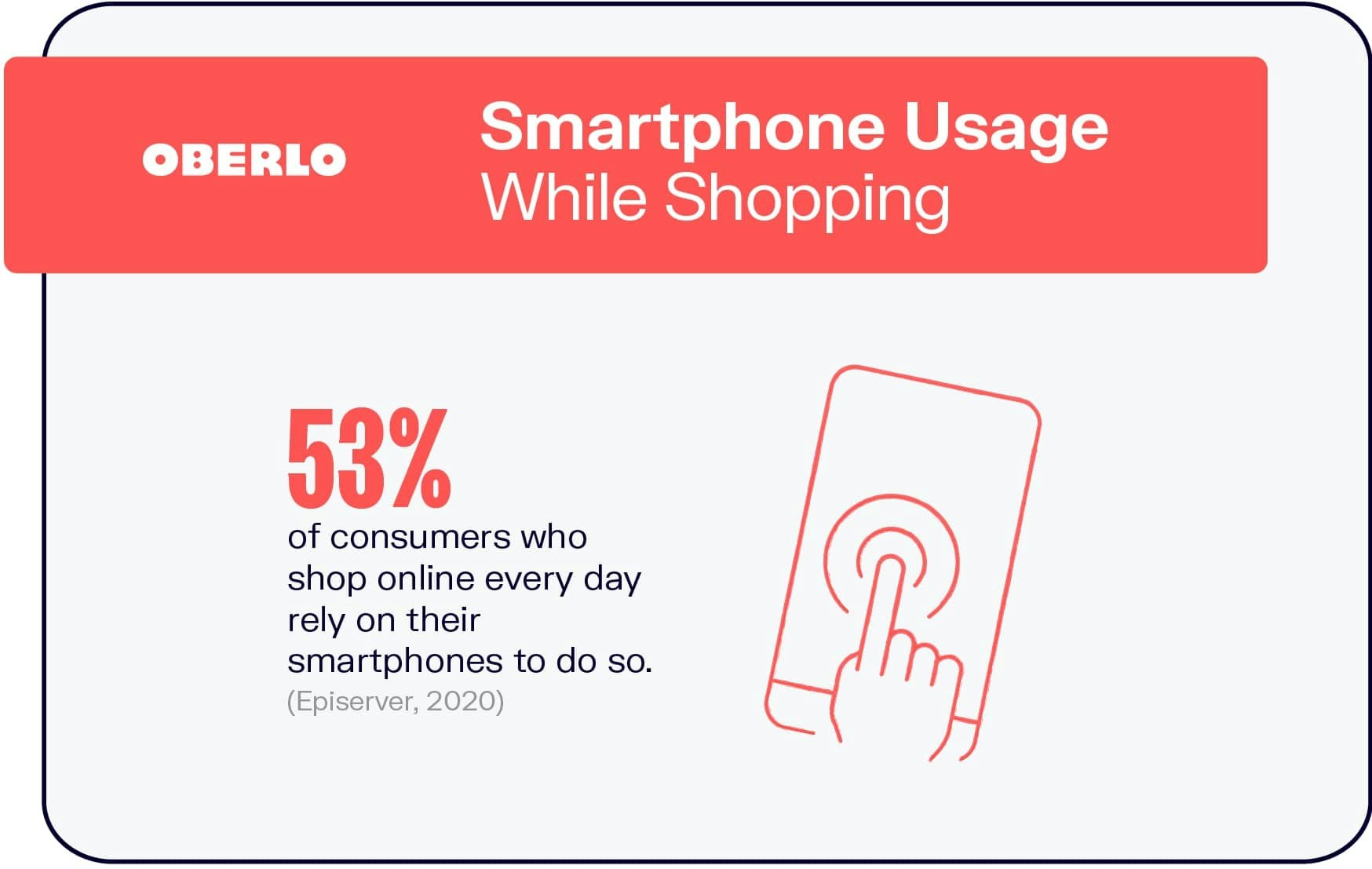
To highlight the growing popularity of mobile commerce, here’s a look at consumers’ online shopping habits.
According to the latest mobile commerce statistics, more than half (53 percent) of consumers who say they shop online every day rely on their smartphones to do so (Episerver, 2020). In fact, they do more online shopping using their smartphones than all other devices combined. These include desktops, laptops, tablets, and smartwatches.
This high dependence on m-commerce isn’t only limited to daily online shoppers. Consumers who claim to “rarely” shop online also prefer to use their smartphones over other devices. Even among those who say they shop just once a year, 36 percent of them turn to their smartphones when they do—compared to the slightly fewer 31 percent who choose their laptops instead.
As a general trend, the more avid the online shopper, the more likely they use their smartphones to purchase items online.
3. US Mobile Commerce Activities
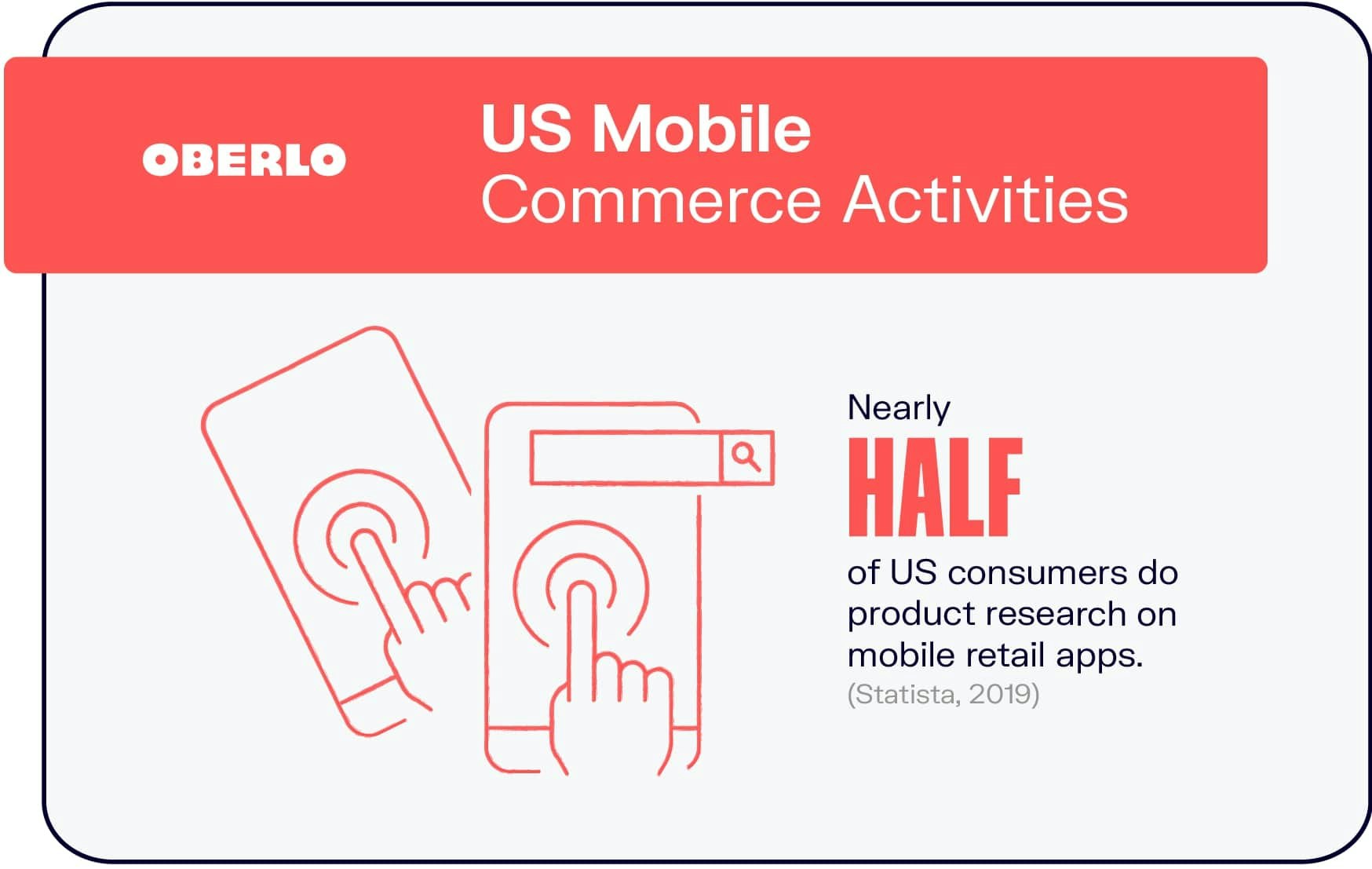
But what sort of shopping activities are consumers carrying out on their mobile devices?
Recent mobile shopping data show that nearly half (46 percent) of US consumers say they look for more information about a product or service through mobile retail apps (Statista, 2019). This makes it the most popular m-commerce activity among mobile users in the US.
This is followed by the act of purchasing the product itself, with four out of every ten consumers doing so via apps.
Using apps to pay for products even when consumers are in the business’s physical store has also become relatively popular. Almost one-quarter of US consumers say they’ve used mobile wallet apps like Apple Pay or Android Pay to pay for their purchased items while they were physically in the store.
Other popular mobile commerce activities include using grocery apps such as Amazon Fresh, FreshDirect, and more, which 20 percent of consumers do, and using shared economy services like Uber and AirBnb.
4. Mobile Usage Accessing the Internet
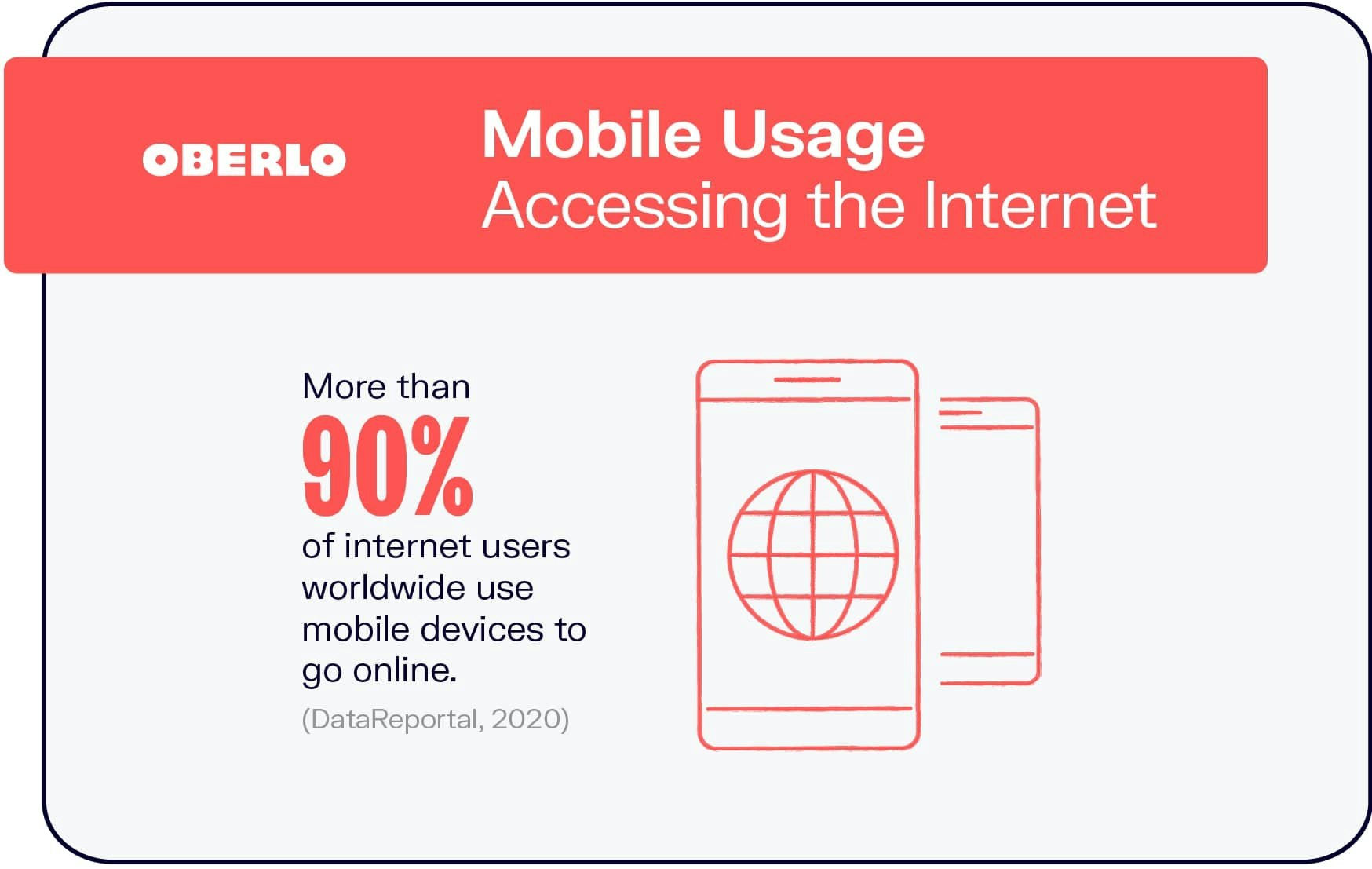
Enhanced connectivity and increased accessibility to smartphones have undoubtedly been one of the biggest drivers of mobile commerce.
M-commerce statistics from July 2020 show that out of the 4.17 billion global internet users, more than nine in ten (91 percent) are using their mobile devices to gain access online (DataReportal, 2020). This makes for approximately 3.8 billion people worldwide.
Smartphones appear to be their device of choice—90 percent of internet users use it to go online.
Even though they’re considered to be old-school and obsolete, feature phones (think your early generation Nokia phones with buttons, a small screen, and no touchscreen capabilities) continue to be used by some people to use the internet. Around 2.8 percent of global internet users, or 117,000 of them, still do so.
On average, internet users spend around three and a half hours connected through their mobile devices every day.
5. Use of Smartphones for M-Commerce
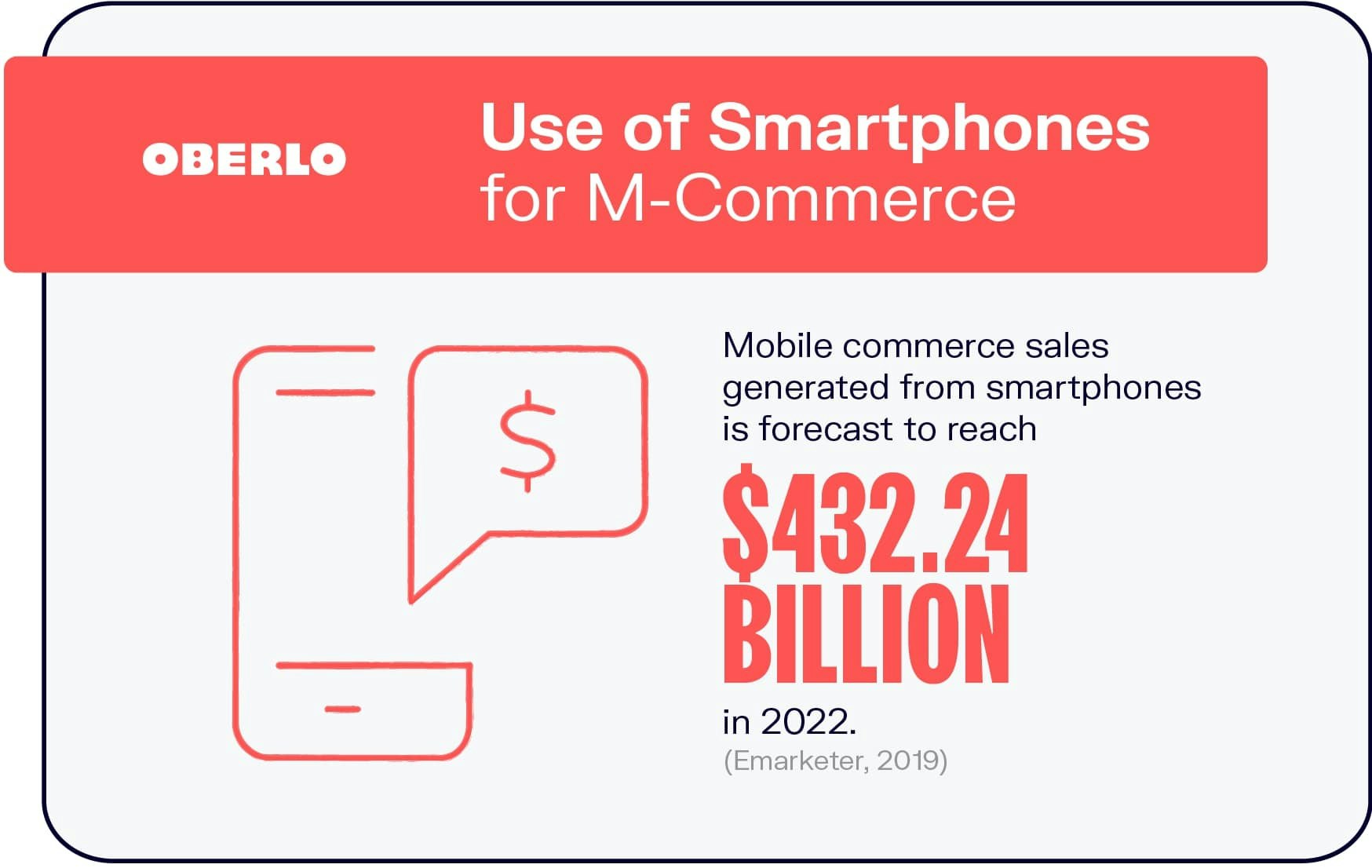
We’ve already established the growing share of mobile commerce in the total US retail ecommerce sales. But what devices are people using for their m-commerce purchases? Let’s break that down further.
With more than 275 million smartphone users in the US, the popularity of the device cannot be denied. It should come as no surprise, then, that analysts expect mobile commerce sales from smartphones to reach $268.21 billion in 2020 and rise further to $432.24 billion in 2022 (Emarketer, 2019).
To understand smartphones’ increasingly vital role in ecommerce, we only have to go back a couple of years.
In 2018, mobile commerce sales from smartphones came in at $148.08 billion—around half of the expected sales in 2020. From 2018 to 2022, the amount of money spent on online shopping by consumers will have increased nearly three-fold.
6. Number of Mobile Buyers in the US
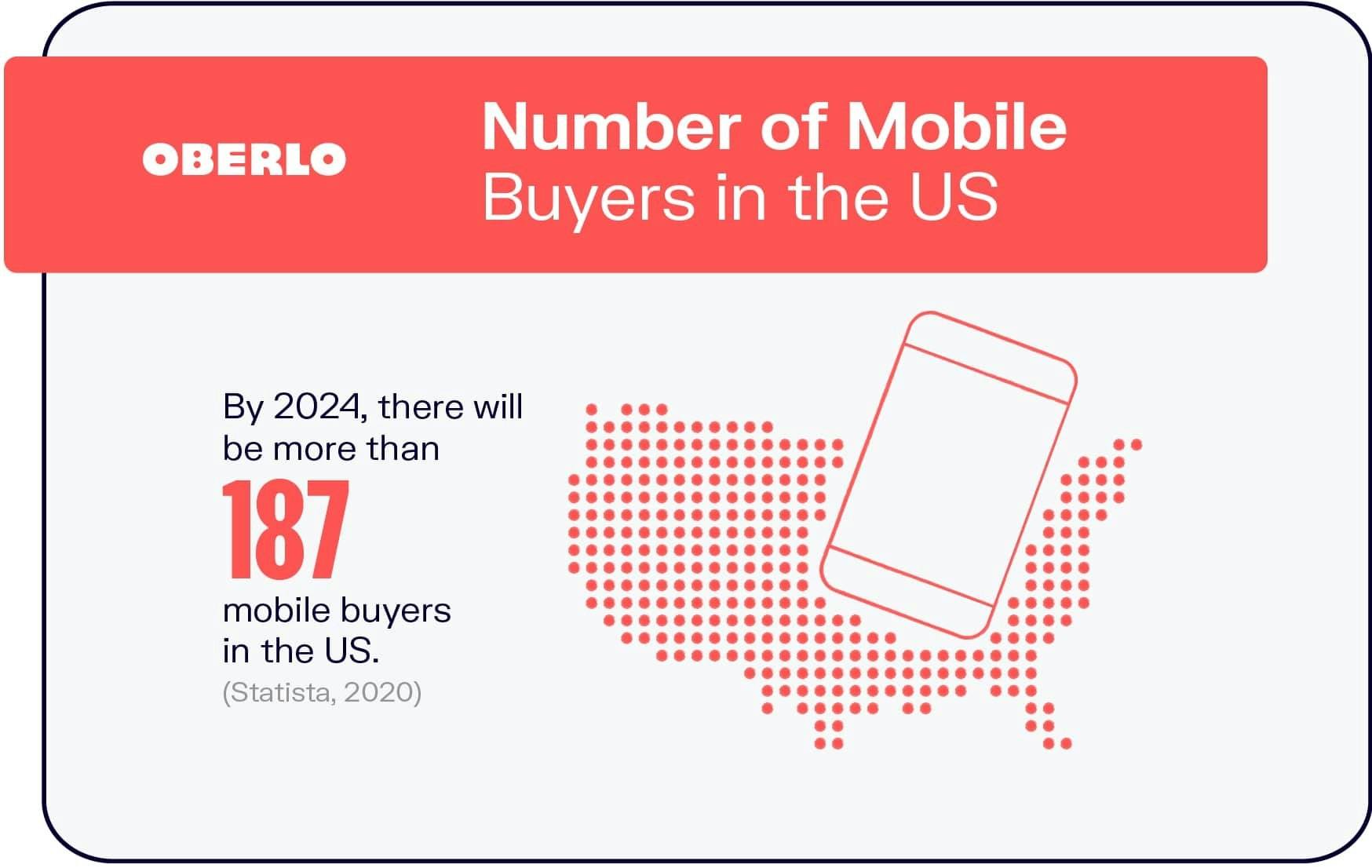
The ease of mobile commerce means that more and more people are jumping on to the popular trend.
In fact, the latest m-commerce statistics show that there are 167.8 million mobile buyers in the US, which account for 60.9 percent of the total US population. This is defined as someone who has made at least one purchase on their mobile device, be it via a website they’re accessing with a web browser or an app they’ve installed on their mobile device.
This number is expected to reach 173.3 billion next year, a slight 0.6 percent annual increase, and further rise to 178.7 billion in 2021. By 2024, it is forecast to exceed 187 million (Statista, 2020).
But how much are they spending? Data shows that the average mobile buyer in the US spends approximately $100 for every purchase. This varies according to device—the average order value for purchases carried out on tablets is slightly higher at $101.96, compared to $94.85 on mobile phones.
7. Mobile Payments in the US
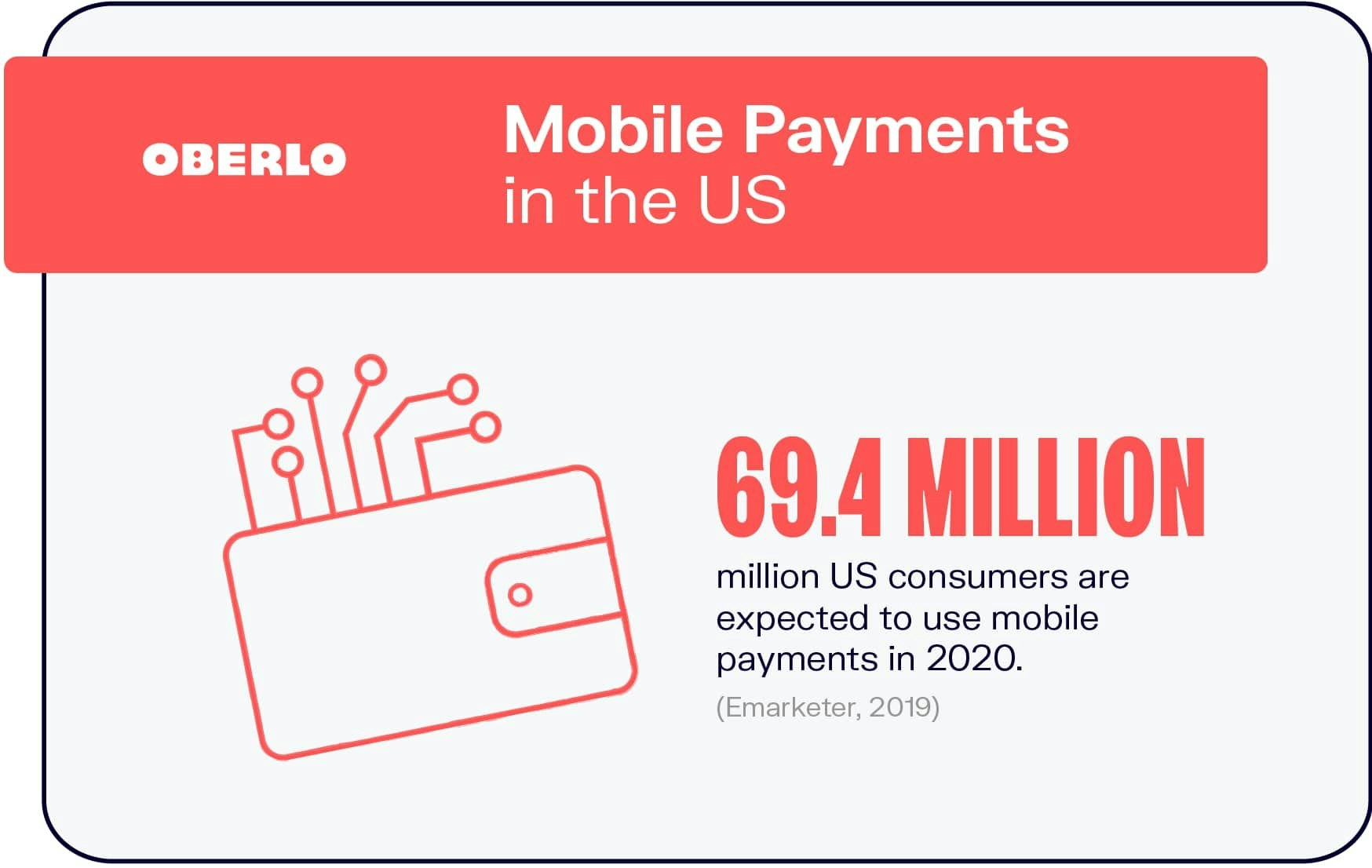
One of the effects of the growing reliance on mobile devices is the rise of mobile payments.
Mobile payments refer to financial transactions done digitally through small, portable, electronic devices like smartphones and tablets, usually for the exchange of products and services.
The latest mobile commerce statistics reflect an increasing number of consumers using mobile payments over the years. In 2020, 69.4 million consumers in the US are expected to pay for a purchase using this method, which is around 30.6 percent of US smartphone users (Emarketer, 2019).
This is an 8.4 percent increase from 2019’s 64 million and all signs currently point to a growing use of mobile payments in the coming years. By 2023, the number of mobile payment users is expected to rise to 80.1 million, or approximately one-third of all smartphone users in the US.
8. Global Mobile Ecommerce Sales
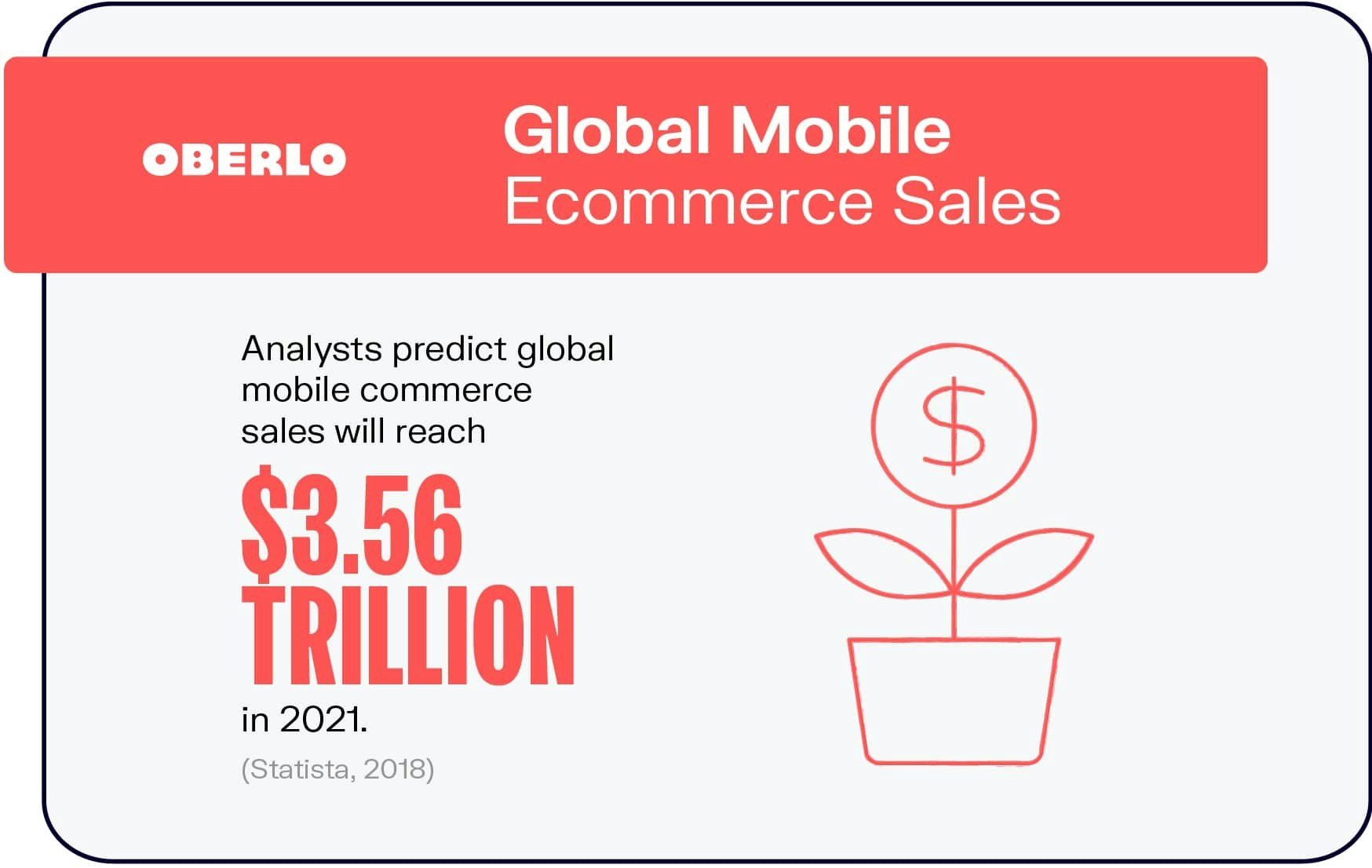
We’ve previously looked at the mobile commerce growth in terms of its share of ecommerce sales. But just how profitable is the m-commerce industry?
According to recent m-commerce statistics, mobile commerce sales is forecast to reach $3.56 trillion by 2021 (Statista, 2018). This will mark a 22.3 percent increase from the $2.91 trillion in sales that’s expected this year.
This is outstanding growth, considering that in 2016, just $970 billion in sales was generated from mobile devices. To put the m-commerce growth into perspective, this will mark an astounding 267 percent increase in just five years.
Given the potential of mobile commerce for businesses, it’s no wonder that more and more retailers are looking into developing their own apps. Coupled with the coronavirus pandemic that has forced people to stay home, as many as 70 percent of consumers have reported spending increasing amounts of time on their phones.
9. Smartphone Usage for Product Research
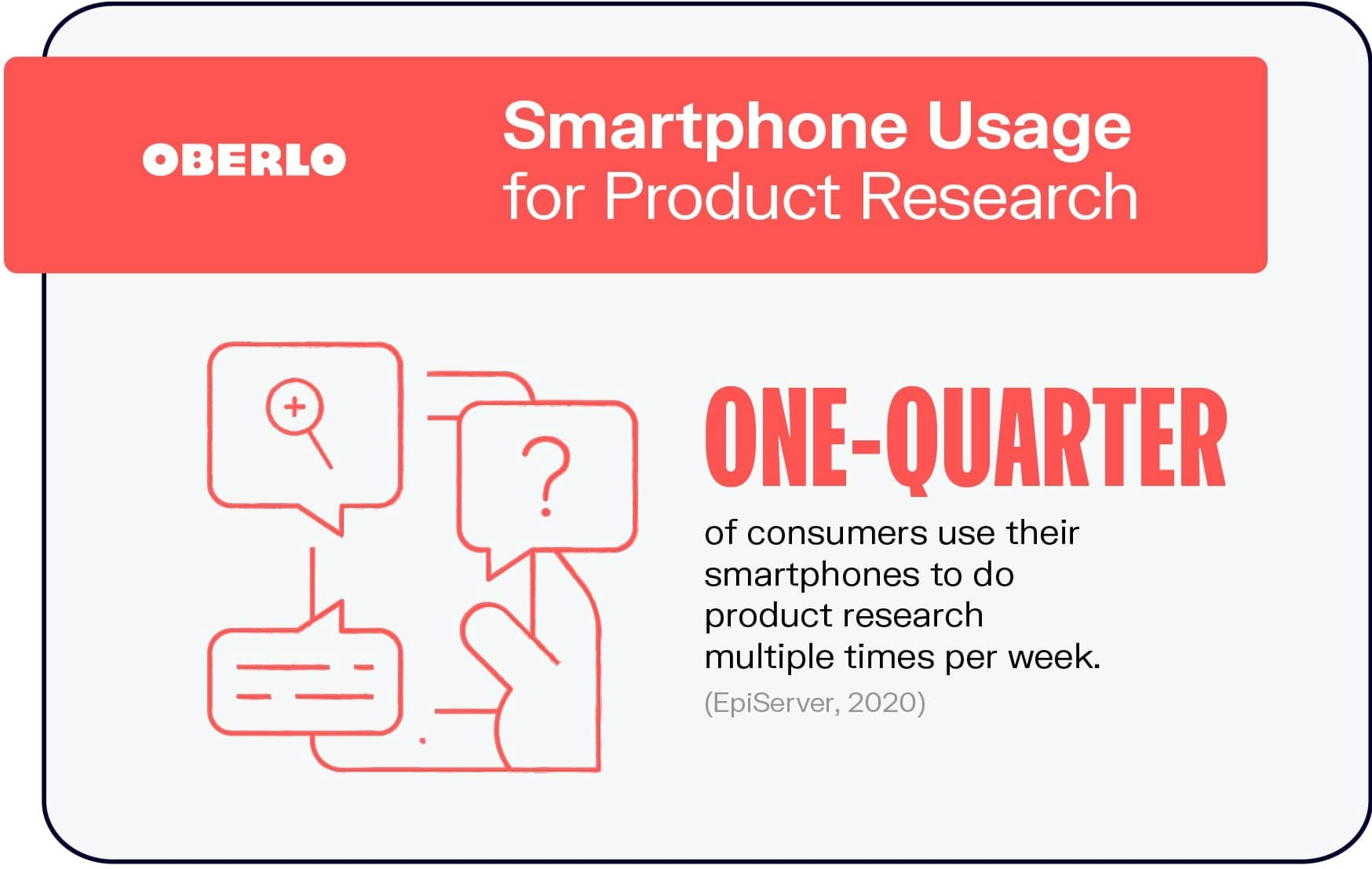
Not only have consumers been increasingly using their smartphones for mobile commerce, but it seems like the reliance has extended beyond just the checkout stage of the purchase funnel.
The latest m-commerce statistics show that more and more consumers are also carrying out product research on their smartphones in 2020. More specifically, one in four of them (25 percent) report researching specific products or services with their smartphones up to multiple times a week (EpiServer, 2020). This is a slight (8.7 percent) increase from the 23 percent who did so in 2019.
Interestingly, most consumers these days appear to prefer to research on their mobile devices despite having a brand employee within reach. Three out of four US consumers say they use their mobile devices for product research while shopping in brick-and-mortar stores.
Experts attribute the shift towards mobile commerce to the improving user-friendliness of smartphone apps. Features like one-click checkout and increased payment options have also helped to facilitate consumers’ journey down the funnel.
10. Most Popular Ecommerce Apps in the US
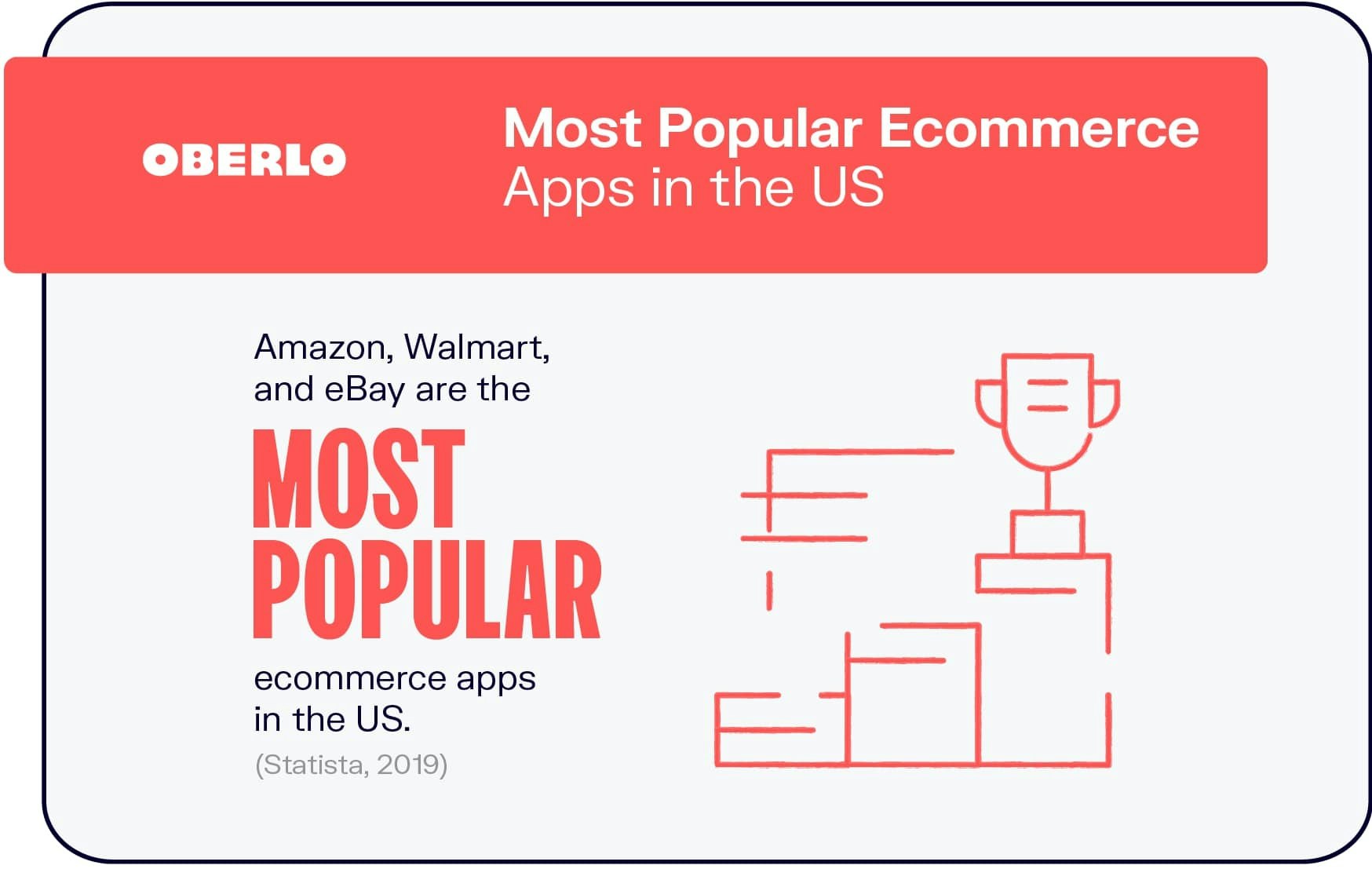
With so many shopping apps available for US consumers, where are most of them choosing to shop from?
Recent mobile commerce statistics show that Amazon currently heads the pack. More than eight out of ten mobile users in the US say they have accessed the Amazon app (Statista, 2019). Incidentally, the company is also the largest ecommerce company, not only in the US but also in the world.
The second-most-popular ecommerce app is Walmart. Just under half (46.08 percent) of US mobile users use the app. Though it ranks second, its reach is nearly half of Amazon’s, which says plenty about the former’s dominance in the ecommerce industry.
Online marketplace eBay is in third place and accessed by around one-third (33.28 percent) of US mobile buyers. Ibotta and Target round up the top five with 25 percent.
Conclusion
There you have it—the top mobile commerce statistics you need to know in 2021.
If you’re an ecommerce business owner or thinking about building an online store, these m-commerce growth figures should have convinced you of the importance of catering to the growing industry.
The potential is certainly there and there’s a chance that your competitors are already benefiting from the ease of mobile shopping. It’s now time for you to jump on the bandwagon, too.

Summary: Mobile Commerce Statistics
Here’s a summary of the Mobile Commerce Statistics you need to know in 2021:
- The mobile commerce share of total ecommerce retail sales in the US is expected to hit 53.9 percent by 2021.
- 53 percent of consumers who shop online every day rely on their smartphones to do so.
- Nearly half of US consumers do product research on mobile retail apps.
- More than 90 percent of internet users worldwide use mobile devices to go online.
- Mobile commerce sales generated from smartphones is forecast to reach $432.24 billion in 2022.
- By 2024, there will be more than 187 mobile buyers in the US.
- 69.4 million US consumers are expected to use mobile payments in 2020.
- Analysts predict global mobile commerce sales will reach $3.56 trillion in 2021.
- One-quarter of consumers use their smartphones to do product research multiple times per week.
- Amazon, Walmart, and eBay are the most popular ecommerce apps in the US.



Want to Learn More?
- 10 Mobile Usage Statistics Every Marketer Should Know in 2021 [Infographic]
- 19 Powerful Ecommerce Statistics That Will Guide Your Strategy in 2021
- Mobile Website Design in 2021: Everything You Need to Know
- The Future of Ecommerce: How Ecommerce Will Change in 2021 and Beyond
Is there anything else you’d like to know about Mobile commerce statistics and wish was included in this article? Let us know in the comments below!
